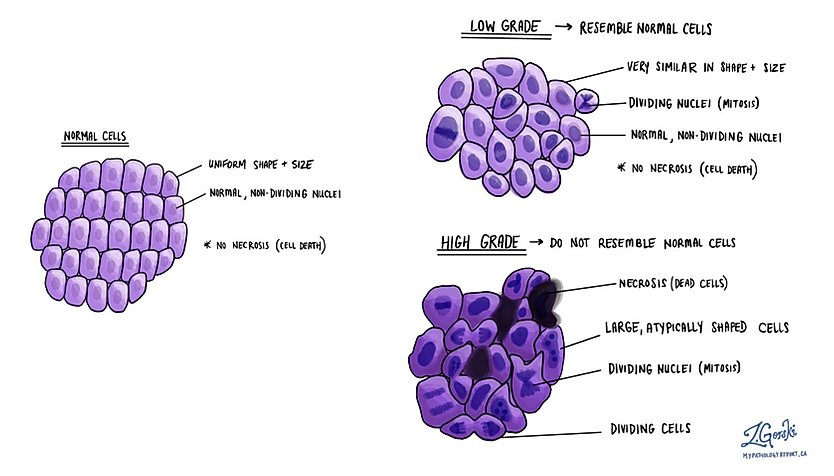ในพยาธิวิทยา "เกรด" เป็นคำที่ใช้เพื่ออธิบายลักษณะที่ปรากฏและพฤติกรรมของเซลล์ภายในตัวอย่างเนื้อเยื่อ โดยทั่วไปคือเนื้องอกที่เป็นมะเร็งและสภาวะของมะเร็ง แต่ยังรวมถึงสภาวะที่ไม่เป็นมะเร็งด้วย เกรดมีความสำคัญเนื่องจากเป็นการให้ข้อมูลบ่งชี้ถึงศักยภาพในการลุกลามของโรคและเป็นแนวทางในการตัดสินใจในการรักษา
การให้คะแนนมะเร็ง
ในบริบทของมะเร็ง การให้คะแนนหมายถึงการประเมินจำนวนเซลล์เนื้องอกที่มีลักษณะคล้ายกับเซลล์ปกติที่เป็นต้นกำเนิดของมะเร็ง การประเมินนี้ดำเนินการภายใต้กล้องจุลทรรศน์โดยนักพยาธิวิทยา โดยพิจารณาถึงระดับของ การเปลี่ยนแปลง ของเซลล์มะเร็ง—ขอบเขตที่เซลล์ที่ผิดปกติเหล่านี้คงลักษณะของเนื้อเยื่อดั้งเดิมเอาไว้
- เกรดต่ำ: เซลล์ที่มีลักษณะคล้ายกับเซลล์ปกติและมีแนวโน้มที่จะเติบโตช้า เกรดนี้บางครั้งเรียกว่า แตกต่างดี.
- ระดับกลาง: เซลล์ที่แสดงความผิดปกติมากขึ้นและมีอัตราการเติบโตและศักยภาพในการแพร่กระจายซึ่งอยู่ตรงกลางระหว่างเกรดต่ำและสูง บางครั้งเกรดนี้ได้รับการอธิบายว่ามีความแตกต่างในระดับปานกลาง
- เกรดสูง: เซลล์ที่มีความผิดปกติสูงจะเติบโตและแพร่กระจายอย่างรวดเร็ว โดยมีความคล้ายคลึงกับเนื้อเยื่อดั้งเดิมเพียงเล็กน้อย เกรดนี้บางครั้งเรียกว่า แตกต่างไม่ดี.
ระดับของมะเร็งมีบทบาทสำคัญในการพิจารณาความลุกลามของโรค และมีอิทธิพลต่อทั้งการพยากรณ์โรคและกลยุทธ์การรักษา

การให้คะแนนสภาวะมะเร็ง: dysplasia
โรคดิสเพลเซีย คือการพัฒนาหรือการเจริญเติบโตของเซลล์ภายในเนื้อเยื่อที่ผิดปกติ และมักจัดอยู่ในภาวะที่เป็นมะเร็ง การจัดระดับ dysplasia เกี่ยวข้องกับการประเมินขอบเขตของความผิดปกติของเซลล์และการหยุดชะงักของสถาปัตยกรรม และช่วยในการคาดการณ์ความเสี่ยงของการลุกลามของมะเร็ง
- dysplasia เล็กน้อย: เซลล์มีความผิดปกติเล็กน้อยและมีความเสี่ยงต่อการเป็นมะเร็งน้อยลง dysplasia เล็กน้อยบางครั้งเรียกว่า dysplasia เกรดต่ำ
- dysplasia ปานกลาง: เซลล์แสดงความผิดปกติในระดับที่สูงกว่า โดยมีความเสี่ยงเพิ่มขึ้นที่จะพัฒนาเป็นมะเร็งเมื่อเทียบกับ dysplasia ที่ไม่รุนแรง dysplasia ระดับปานกลางสามารถอธิบายได้ว่าเป็น dysplasia ระดับต่ำหรือระดับสูงทั้งนี้ขึ้นอยู่กับพื้นที่ของร่างกายที่เกี่ยวข้อง
- dysplasia รุนแรง: เซลล์มีความผิดปกติอย่างมีนัยสำคัญและมีลักษณะคล้ายกับเซลล์มะเร็งอย่างใกล้ชิด ซึ่งแสดงถึงความเสี่ยงสูงที่จะลุกลามไปสู่มะเร็งที่ลุกลาม dysplasia ระดับรุนแรงบางครั้งเรียกว่า dysplasia ระดับสูง
การจัดระดับของ dysplasia มีความสำคัญอย่างยิ่งในสภาวะต่างๆ เช่น เนื้องอกในเยื่อบุผิวปากมดลูก (CIN) ซึ่งเป็นแนวทางในการติดตามและการรักษาเพื่อป้องกันการพัฒนาของมะเร็งปากมดลูก
การให้เกรดของสภาวะที่ไม่เป็นมะเร็ง
ในสภาวะที่ไม่เป็นมะเร็งบางชนิด การให้เกรดสามารถใช้เพื่ออธิบายความรุนแรงหรือขอบเขตของความผิดปกติของเนื้อเยื่อได้ ตัวอย่างเช่น การจัดระดับอาจนำไปใช้กับสภาวะการอักเสบ ซึ่งอาจสะท้อนถึงระดับความเสียหายของเนื้อเยื่อหรือการอักเสบ แม้ว่าจะไม่ได้นำไปใช้ในระดับสากลในลักษณะเดียวกับในมะเร็งหรือสภาวะมะเร็ง แต่การทำความเข้าใจระดับในบริบทเหล่านี้สามารถช่วยในการประเมินความรุนแรงของโรคและการวางแผนการรักษา
เกี่ยวกับบทความนี้
แพทย์เขียนบทความนี้เพื่อช่วยให้คุณอ่านและทำความเข้าใจรายงานพยาธิวิทยาของคุณ สอบถามเพิ่มเติม หากคุณมีคำถามเกี่ยวกับบทความนี้หรือรายงานพยาธิวิทยาของคุณ หากต้องการทราบข้อมูลเบื้องต้นเกี่ยวกับรายงานพยาธิวิทยาของคุณ โปรดอ่าน บทความนี้.


